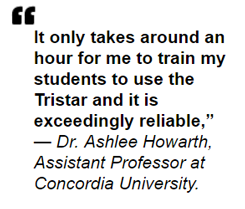Researchers designing and synthesizing new metal–organic frameworks (MOFs) at Concordia University (Montreal, Canada) are benefiting from high throughput surface area and porosity characterization with a Micromeritics TriStar II Plus automated, three-station gas adsorption system. A key focus for the group is rare earth MOFs with potential for wastewater clean-up and luminescence-based hazardous chemical detection. The TriStar characterizes new MOFs with exemplary efficiency, even for novice users, enhancing the productivity of the lab and accelerating progress.
“Surface area and porosity are defining characteristics of a MOF,” said Dr. Ashlee Howarth, Assistant Professor at Concordia University. “So, we need to be able to measure them as quickly and efficiently as possible. The TriStar runs 3 samples at a time, generating full data sets in 7 to 8 hours. This is extremely fast and means a same day result for my students; with some systems it would take 24 hours to run just a single sample. The ability to run three samples at once is really useful for confirming the reproducibility of a preparation method.”
MOFs are an exciting class of chemical compounds with tunable porosity at the nanoscale and associated potential to address a wide range of societal concerns. The Concordia team are preparing MOFs to remove and/or catalytically breakdown waterborne contaminants not amenable to existing treatments, such as antibiotics and personal care products. The ability for rare earth MOFs to exhibit luminescence in response to the presence of hazardous analytes is also an area of interest. Surface area and porosity are performance-defining characteristics for all MOFs with pore size distribution providing insight into likely application.

“I’m not aware of another system that matches it in terms of that crucial combination of robustness, throughput and price. I will soon boost analytical capabilities further with the addition of a Smart VacPrep accessory which will speed up all stages of sample prep – both degassing and activation.”
Prior to gas adsorption analyses samples are degassed; catalytic materials may also be activated. The Smart VacPrep is an advanced six-port, programmable system that streamlines sample preparation by heating and evacuation. Each port can be operated independently, with samples easily and seamlessly transferred to the TriStar once preparation is complete. Using the Smart VacPrep in combination with the TriStar therefore further enhances the speed and ease of gas adsorption analysis.
Find out more about:




